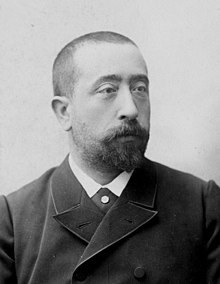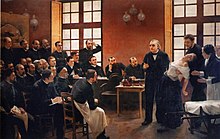SandyGeorgia (talk | contribs) Undid revision 943711840 by Elisesophie (talk) already linked in this very same section, no need to link twice Tag: Undo |
Martinevans123 (talk | contribs) →Personal life and decline: add AJ Lees (1986) as source - this seems to be the text that the current "Enerson" source has "borrowed from" |
||
| Line 34: | Line 34: | ||
Gilles de la Tourette married his cousin Marie Detrois (1867–1922) on 2 August 1887 in Loudon. [[Paul Brouardel]] and Charcot were witnesses. They had four children, three of whom lived to adulthood.<ref>{{Cite book |title=Georges Gilles de la Tourette: Beyond the Eponym, a Biography |last=Walusinski |first=Olivier |date=2019 |publisher=Oxford University Press |isbn=978-0-19-063603-6 |pages= 13–16 }}</ref> |
Gilles de la Tourette married his cousin Marie Detrois (1867–1922) on 2 August 1887 in Loudon. [[Paul Brouardel]] and Charcot were witnesses. They had four children, three of whom lived to adulthood.<ref>{{Cite book |title=Georges Gilles de la Tourette: Beyond the Eponym, a Biography |last=Walusinski |first=Olivier |date=2019 |publisher=Oxford University Press |isbn=978-0-19-063603-6 |pages= 13–16 }}</ref> |
||
In 1893, a former female patient shot Gilles de la Tourette in the head, claiming he had hypnotized her against her will. Both Tourette and many modern hypnologists state that this is impossible. His mentor, Charcot, had died recently, and his young son had also died recently. After these events, Tourette began to experience mood swings between depression and [[hypomania]]. Nevertheless, he organized public lectures in which he spoke about literacy, mesmerism and theatre.<ref name="Enerson" /> |
In 1893, a former female patient shot Gilles de la Tourette in the head, claiming he had hypnotized her against her will. Both Tourette and many modern hypnologists state that this is impossible. His mentor, Charcot, had died recently, and his young son had also died recently. After these events, Tourette began to experience mood swings between depression and [[hypomania]]. Nevertheless, he organized public lectures in which he spoke about literacy, mesmerism and theatre.<ref name="Enerson" /><ref>https://www.ncbi.nlm.nih.gov/pubmed/3547546</ref> |
||
Around 1902, Gilles de la Tourette's condition worsened and he was dismissed from his post. Gilles de la Tourette died on 26 May 1904 in a psychiatric hospital in [[Lausanne]], Switzerland.<ref name="Enerson" /> |
Around 1902, Gilles de la Tourette's condition worsened and he was dismissed from his post. Gilles de la Tourette died on 26 May 1904 in a psychiatric hospital in [[Lausanne]], Switzerland.<ref name="Enerson" /> |
||
Revision as of 14:50, 3 March 2020
Georges Gilles de la Tourette | |
|---|---|
 | |
| Born | Georges Albert Édouard Brutus Gilles de la Tourette 30 October 1857 Saint-Gervais-les-Trois-Clochers, Vienne, France |
| Died | 26 May 1904 (aged 46) Lausanne, Switzerland |
| Known for | Tourette syndrome |
Georges Albert Édouard Brutus Gilles de la Tourette (French: [ʒɔʁʒ albɛʁ edwaʁ bʁytys ʒil də la tuʁɛt]; 30 October 1857 – 26 May 1904) was a French physician and the namesake of Tourette syndrome, a neurological condition characterized by physical and verbal tics.[1] He could be retrospectively classified as a neurologist, but the field did not exist in his time. His main contributions in medicine were in the fields of hypnotism and hysteria.[1]
Early years
Gilles de la Tourette was born the oldest of four children on 30 October 1857[1] in the small town of Saint-Gervais-les-Trois-Clochers in the district of Châtellerault, near the city of Loudun.[2]
During 1873, Gilles de la Tourette began medical studies at Poitiers at the age of sixteen.[1] In 1881, he relocated to Paris, where he continued his studies at the Laennec Hospital.[1]
Career

Gilles de la Tourette began his internship in 1884, working "at a superhuman pace, publishing, teaching and practicing clinical medicine".[1] He became a student, amanuensis, and house physician of his mentor, the influential contemporary neurologist Jean-Martin Charcot, director of the Salpêtrière Hospital. Charcot also helped him to advance in his academic career. Tourette studied and lectured in psychotherapy, hysteria and medical and legal ramifications of mesmerism (modern-day hypnosis).[3] Colleagues and historians have described Gilles de la Tourette as a "highly intelligent, if irascible, character".[1]
In 1884, Charcot asked Gilles de la Tourette to work on motor disorders; latah, myriachit and the Jumping Frenchmen of Maine had recently been described, and Gilles de la Tourette believed the conditions were related and separate from chorea.[1] Gilles de la Tourette described the symptoms of Tourette syndrome in one patient and collected previous observations of similar cases, and in 1885 he published a further nine cases using the name "maladie des tics" for the disorder.[4] Charcot renamed the syndrome "Gilles de la Tourette's illness" in his honor,[3] although Gilles de la Tourette's work was not well received at Salpêtrière.[1]
Gilles de la Tourette published an article on hysteria in the German Army, which angered Bismarck, and a further article about unhygienic conditions in the floating hospitals on the river Thames. With Gabriel Legué he analyzed 17th century abbess Jeanne des Anges' account of her hysteria that was allegedly based on her unrequited love for a priest Urbain Grandier, who was later burned for witchcraft.[3]
Personal life and decline

Gilles de la Tourette married his cousin Marie Detrois (1867–1922) on 2 August 1887 in Loudon. Paul Brouardel and Charcot were witnesses. They had four children, three of whom lived to adulthood.[5]
In 1893, a former female patient shot Gilles de la Tourette in the head, claiming he had hypnotized her against her will. Both Tourette and many modern hypnologists state that this is impossible. His mentor, Charcot, had died recently, and his young son had also died recently. After these events, Tourette began to experience mood swings between depression and hypomania. Nevertheless, he organized public lectures in which he spoke about literacy, mesmerism and theatre.[3][6]
Around 1902, Gilles de la Tourette's condition worsened and he was dismissed from his post. Gilles de la Tourette died on 26 May 1904 in a psychiatric hospital in Lausanne, Switzerland.[3]
Writings
Gilles de la Tourette published sixteen papers on hysteria, including:[1]
- Les actualités médicales, les états neurasthéniques (Paris 1898)
- Leçons de clinique thérapeutique sur les maladies du système nerveux (Paris 1898)
- L'hypnotisme et les états analogues au point de vue médico-légal (Paris, 1887; 2nd. edition Paris 1889)
- Les actualités médicales. Formes cliniques et traitement des myélites syphilitiques' convulsifs (La semaine médicale 1899)
- Traité clinique et thérapeutique de l'hystérie d'après l'enseignement de la Salpêtrière (Paris 1891)
References
- ^ a b c d e f g h i j Rickards H, Cavanna AE (2009). "Gilles de la Tourette: the man behind the syndrome". J Psychosom Res. 67 (6): 469–74. doi:10.1016/j.jpsychores.2009.07.019. PMID 19913650.
- ^ Teive HA, Chien HF, Munhoz RP, Barbosa ER (December 2008). "Charcot's contribution to the study of Tourette's syndrome". Arq Neuropsiquiatr. 66 (4): 918–21. doi:10.1590/S0004-282X2008000600035. PMID 19099145.
- ^ a b c d e Enersen OD. "Georges Albert Édouard Brutus Gilles de la Tourette". Who Named It?. Archived from the original on 9 March 2005. Retrieved 14 May 2007.
- ^ Dana CL, Wilkin WP (1886). "On convulsive tic with explosive disturbances of speech (So-called Gilles de la Tourette's Disease)". The Journal of Nervous and Mental Disease. 13 (7): 407–412. doi:10.1097/00005053-188607000-00004.
- ^ Walusinski, Olivier (2019). Georges Gilles de la Tourette: Beyond the Eponym, a Biography. Oxford University Press. pp. 13–16. ISBN 978-0-19-063603-6.
- ^ https://www.ncbi.nlm.nih.gov/pubmed/3547546
Further reading
- Bogousslavsky J, Walusinski O (September 2010). "Gilles de la Tourette's criminal women: the many faces of fin de siècle hypnotism". Clin Neurol Neurosurg. 112 (7): 549–51. doi:10.1016/j.clineuro.2010.03.008. PMID 20413214.
- Lees AJ (1986). "Georges Gilles de la Tourette. The man and his times". Rev. Neurol. (Paris). 142 (11): 808–16. PMID 3547546.